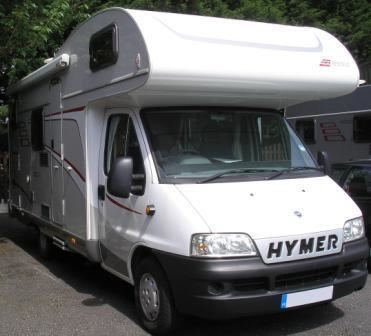 | ||
A motorhome (or motor coach) is a type of self-propelled recreational vehicle or RV which offers living accommodation combined with a vehicle engine. The term motorhome is most commonly used in the United Kingdom, United States, Canada, and Australia.
Contents
Motorhomes are part of the much larger associated group of mobile homes which includes caravans, also known as tourers, and static caravans. The overarching 'mobile leisure' terminology encompasses all aspects of the industry from caravan parks, sales dealerships, manufactures, holiday parks through to the vast supporting services to the sector.
Features
A motorhome comprises sleeping accommodation for between two and eight people. Each sleeping place is called a berth. Each berth is either fixed or converts from another part of the motorhome's interior, usually a fold-out sofa. A kitchenette area will contain cooking equipment. The type of equipment included differs depending on the motorhome make and model, but generally a kitchenette has an oven, grill, stovetop, and sink. More luxury models may also provide a microwave. A separate washroom will be housed in the motorhome. Each washroom will have a flushing cassette toilet, shower, and basin. The cassette toilet sometimes swivels to provide extra room and can be accessed from outside the motorhome for easy emptying. More recent motorhomes will have a separate shower cubicle.
A motorhome will also have a cab area with a driver and passenger seat. These seats often swivel to become part of the living space. A dinette area provides a table and seating space typically used for eating meals. A lounge may also be included, consisting of either a U-shaped sofa located in the rear of the motorhome or a side lounge.
Ambiguity with RV and campervan
The term motorhome is often used interchangeably with (American) RV and campervans, though the terms are not entirely synonymous. Their term Recreational Vehicle (RV) is actually a blanket term that refers to all forms of mobile, temporary, dwelling vehicles of this type (and as such includes motorhomes, as well as travel trailers, fifth wheels, and truck campers).
Campervans are typically smaller than motorhomes and are constructed differently. Whilst campervans are focused on mobility and low cost, motorhomes have more emphasis on comfort. For example, campervans generally lack built-in toilets and showers, or a divide between the living compartment and the cab. Volkswagen Westfalia Campers are typical campervans.
History
The origins of the motorhome date back to 1910, when the Pierce-Arrow motor company introduced the Touring Landau model at the Madison Square Garden auto show. The Pierce-Arrow’s entry was specialized for the camper in mind—providing cargo compartments for camping equipment and even an on-board toilet. In the 1920s, individual builders and manufactures began to convert panel trucks and buses to be used for camping. Designers patterned these housecars after airplanes, boats, and buses. RV production was halted during World War Two and would not resume for tourists until the 1950s. When production did resume, designers began grafting trailer bodies onto truck or bus chassis.
Raymond Frank gave these housecars their contemporary name of “motorhomes.” Following a model common in RV history, in 1958 Frank designed his first motorhome so his family could take vacations to Florida and the mid-west. The 27-foot motorhome, mounted on a Dodge chassis, soon caught the eye of fellow campers who asked Frank to build them one, too. By 1960, the Frank’s had sold seven motorhomes and decided to open Frank Motor Homes, Inc. the next year. With the stylish fiberglass construction and contemporary color palate, the Frank motorhomes became an acceptable option for 1960s suburbanites who wanted a RV but scoffed at the travel trailer.
Soon other firms began to manufacture these mainstream motorhomes. In 1958, one of the most recognizable names in motorhomes was launched—Winnebago. Under the direction of John Hanson, Winnebago began to produce nearly all of their motorhomes’ components other than the chassis. As Hanson explained, “The cheapest way to get things done is to do them yourself.” In ten years, Winnebago had grown from 415 employees to 1,252 in 1969 with over $3 million in sales. While Winnebago was the market leader, other companies were also growing. In 1969 a total of 23,100 motorhomes were sold. While the gas crunch of the 1970s drove many manufactures out of business—including Frank Motorhomes (then known as Travco)—today, the motorhome market continues to be strong. In 2014, 43,900 motorhomes were sold in the United States.
Categories
Motorhomes can be roughly categorized into three categories:
Layouts
There are many different motorhome layouts available with each manufacturer offering a range of options.
Other terms
In the United Kingdom and United States, the word motorhome is commonly used. On occasion, other synonyms are used, such as motor home and motor caravan.
In Germany, a motorhome is referred to as a "Wohnmobil". In Sweden, the term "Husbil" means motorhome. In France, a motorhome is called a "camping-car". In Italy, the term "Camper" is used to mean motorhome in general, and the term "Motorhome" refers to Class A motorhomes in particular. Spain and Portugal use "Auto Caravana" or "Auto-Caravana".
In Australia and New Zealand, the term campervan is frequently used for smaller vans, either with a low top or high top that don't have a toilet and shower. In New Zealand you may also hear the term housebus that is frequently used for larger motorhomes.
In some countries, the proprietary name Winnebago has been largely genericised to refer to any motorhome.
